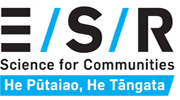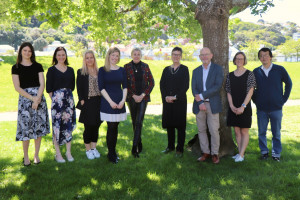The Environmental Science and Research Institute (ESR) welcomes today’s announcement by the Health Research Council (HRC)(external link) that the prestigious Liley Medal has been award to a multi-agency team led by ESR Public Health expert, Dr Sarah Jefferies, for a landmark paper analysing the impact of New Zealand’s initial response to the COVID-19 pandemic.
The award, part of the Royal Society Te Apārangi’s Research Honours, is presented for a piece of outstanding work that is internationally recognised and a leading contributor to health research in New Zealand. It highlights the national and global significance of the highly cited epidemiological study which was published in the Lancet Public Health in October 2020.
The study considered the impact of the initial interventions during the first wave on critical outcomes like health equity and highlighted vital considerations for the management of future pandemic responses.
ESR Chief Executive, Peter Lennox, says the recognition reinforced the benefits of building on existing relationships to collaboratively tackle COVID-19.
“The award highlights the importance of a world-class surveillance system informing epidemiological research to better understand the pandemic and plan for the future.
“We count ourselves very lucky at ESR to have the operational and research expertise of Dr Jefferies and many others across our own and collaborating organisations. This means we can draw upon extensive expertise in our drive for better outcomes for New Zealand’s communities. This award is due recognition of the exceptional work the team has done.”
Dr Jefferies, who specialises in communicable disease surveillance and responses to outbreaks, says she and the team are deeply honoured to receive the Medal.
“A study like this doesn’t happen without a great deal of collaboration. Not only from the study authors but from many more individuals and organisations across New Zealand. There has been a myriad of contributors who have all played vital roles in combating COVID-19 in New Zealand, not least the extraordinary efforts of frontline workers, the laboratory staff around the country, and the enormous effort of our public health colleagues. They continue to detect, trace and manage the intensive response to COVID-19, and collect the surveillance data which is vital to informing New Zealand’s ongoing response.”
Dr Jefferies personally acknowledges her ESR colleagues: Charlotte Gilkison; Giles Graham; Dr Virginia Hope; Dr Andrea McNeill; Shevaun Paine; Dr Namrata Prasad; Dr Julia Scott; and Dr Jill Sherwood.
“The team have played key roles in supporting New Zealand’s surveillance system to help inform the response to COVID-19, as well their important inputs to the study. And it has been an honour to collaborate with Distinguished Professor Nigel French and Associate Professor Jonathan Marshall of Massey University, Professor Patricia Priest of Otago University, Drs Petra Muellner and Liang Jang of Epi-Interactive, and Dr Caroline McElnay, Director of Public Health for the Ministry of Health.’”
Co-author Distinguished Professor Nigel French said, “The medal is recognition of the skill and dedication of Dr Jefferies and her ESR colleagues, and of the importance of collaboration at a time of crisis. We were delighted to be involved in the study and to have the opportunity to work alongside colleagues from ESR and Otago. The work would not have been possible without the high quality surveillance carried out by ESR, and of course the outcome of elimination in 2020 was a credit to the team of 5 million New Zealanders.”
END
For more information:
Ian Long
Senior Communications Advisor, ESR
Kenepuru Science Centre, 34 Kenepuru Drive, Porirua 5022
M: 027 235 5263
W: www.esr.cri.nz(external link)
Background
Outline of scientific findings
The study showed the impacts of New Zealand’s non-pharmaceutical measures on COVID-19 health outcomes, health equity, and initial control of the novel pandemic virus. It provides evidence to the international community of how the multi-faceted components of New Zealand’s stringent, evidence-informed response led to the low relative burden of COVID-19 and disparities, and initial achievement of COVID-19 elimination at the start of the pandemic.
New Zealand’s response was notable for its strict border closures, rapid implementation of national lockdown and rapid surveillance enhancements, enabled by the collective efforts of multiple agencies, health workers and communities. There was a marked reduction in disease transmission in the first two weeks of lockdown, and cases were increasingly contact traced and rapidly detected.
The study showed New Zealand followed WHO (World Health Organization) advice and combined effective leadership and communication strategies. Rapid control of community transmission through mandatory physical distancing provided time to enhance the response, including prioritised testing of higher-risk groups, also ensuring that COVID-19 did not overburden health system capacity.
In the first wave older people, Aged Residential Care residents, people with underlying conditions, and Asian and Pacific peoples were at higher risk of severe outcomes than other populations. Inequitable morbidity and mortality for Māori and Pacific peoples, seen during previous influenza pandemics, continue for many communicable diseases today. This inequitable impact has also been demonstrated in subsequent COVID-19 outbreaks in NZ.
The study supports the ongoing need for the response to address systemic barriers, such as health-care access, to achieving equitable health outcomes for Māori and Pacific peoples and higher-risk groups. And, it shows the importance of the foundations of public health practice: physical distancing, good hygiene, test, trace, quarantine, isolate, co-ordinate, communicate.
Methods
All COVID-19 cases reported in New Zealand on EpiSurv – the national notifiable disease database – were examine and all people tested for infection, recorded on Éclair - the national SARSCoV-2 test results repository. The study collected information from 2 February when the first travel restriction was implemented until 13 May, the last day of Alert Level 3, after which time community transmission initially ceased.
New Zealand’s response was characterised by a very rapid escalation of alert levels over five days. It was not possible to examine the impact of individual alert levels, so the study period was split into five phases.
Phase 1 included initial travel restrictions, Phase 2 was the 10-day period of rapid escalation of measures just before lockdown, Phase 3 and 4 were the first and second halves of lockdown, respectively, and phase 5, the first de-escalation to Alert Level 3.
To look at epidemiological impacts, cases were assigned to these phases in two ways, exposure and response periods. Effectively, the date they were exposed to the virus, and the date they presented with illness or were diagnosed with infection. Modelling to estimate the exposure dates of cases was used.
In terms of outcome measures, the team wanted to know how various outcomes changed during different phases of the response, including the estimated rate of cases infected per day, the demographic features of cases and disease outcomes, patterns of disease transmission, testing coverage, and we used multivariable analyses to look a risk factors for severe outcomes and maximum likelihood estimation to summarise time to event intervals.
New Zealand had one of the lowest case counts, cumulative incidence and mortality rates among higher income countries during the first wave, with only 1503 cases, 95 hospitalisations and 22 deaths to 13 May 2020. When New Zealand’s response is compared with other countries, New Zealand had the earliest, most stringent application of available public health measures.
Response team
This work is also important in being authored by representatives of the enhanced public health workforce who have been providing strategic and operational advice and real-time analyses to the New Zealand Ministry of Health and Government during the initial COVID-19 response.
The study was led by public health expert, Dr Sarah Jefferies, and a team of epidemiologists and analysts at ESR, with multi-agency collaborators including Distinguished Professor Nigel French and Associate Professor Jonathan Marshall from Massey University; Professor Patricia Priest from Otago University and Dr Virginia Hope from ESR; Dr Caroline McElnay, Director of Public Health at the Ministry of Health; Dr Petra Muellner, Director of Epi-Interactive. The study built on the work of the COVID-19 response team at ESR who provide public health communicable disease surveillance advice to the Ministry of Health, working in the response day to day.

